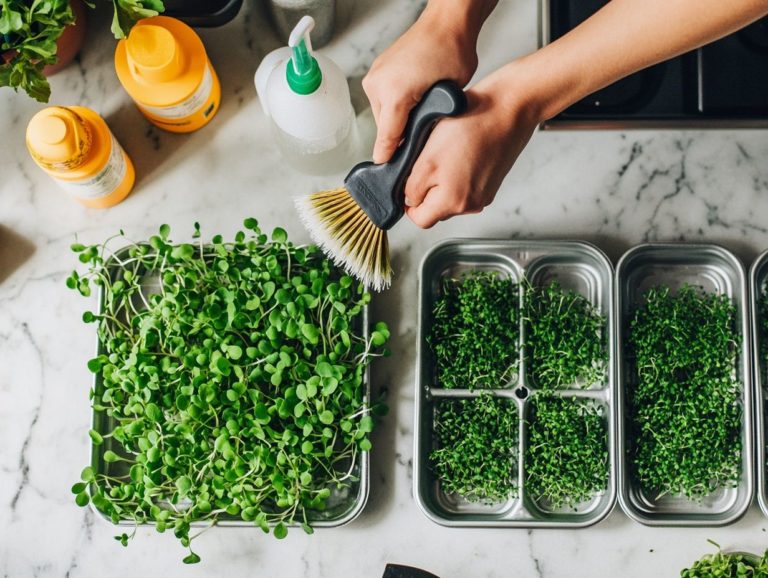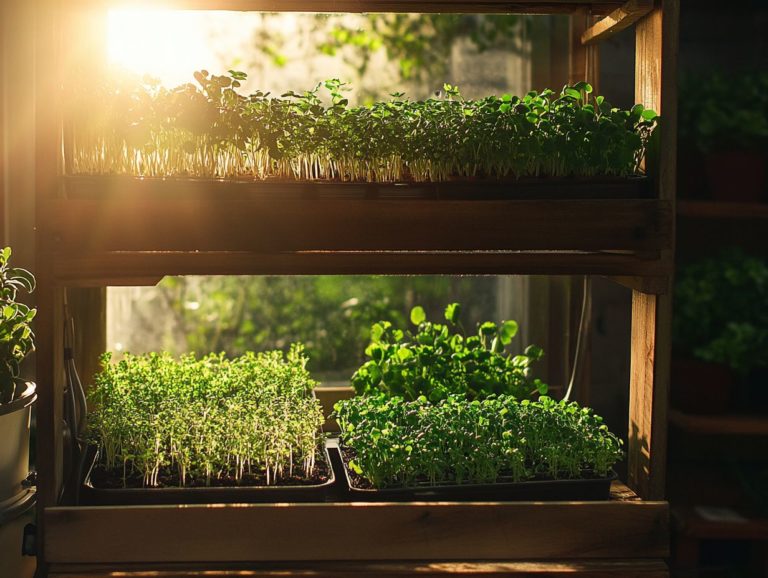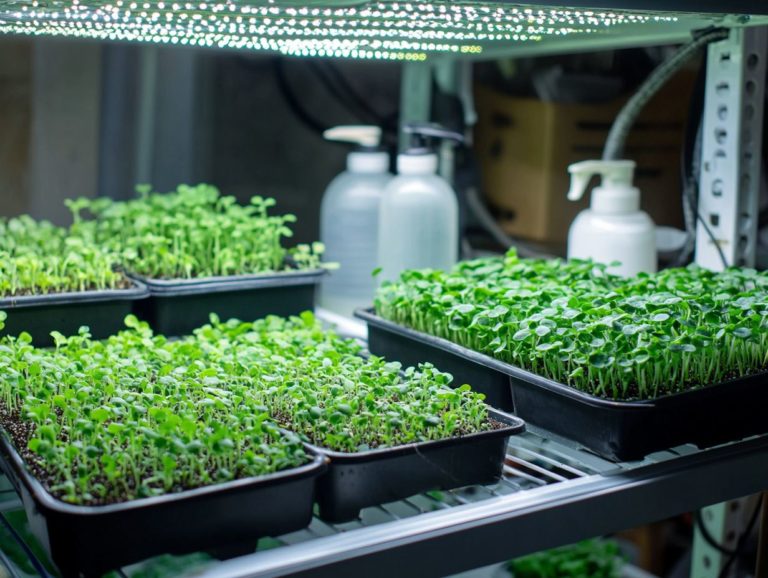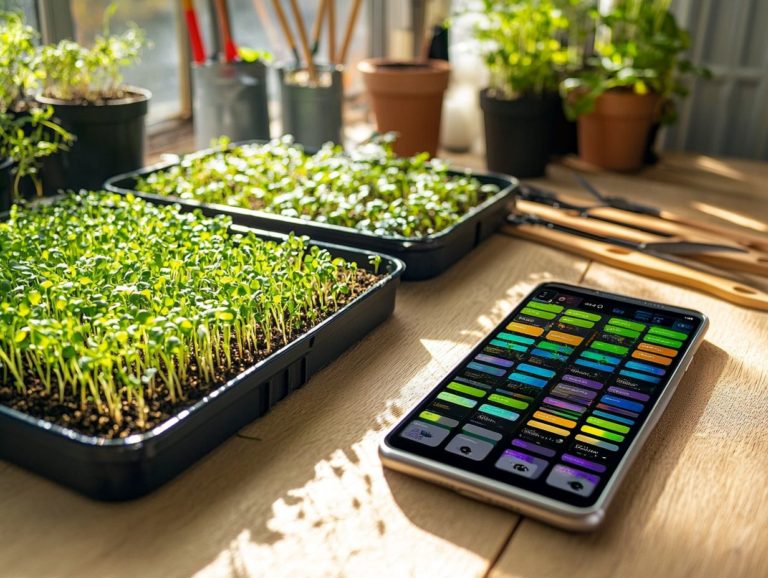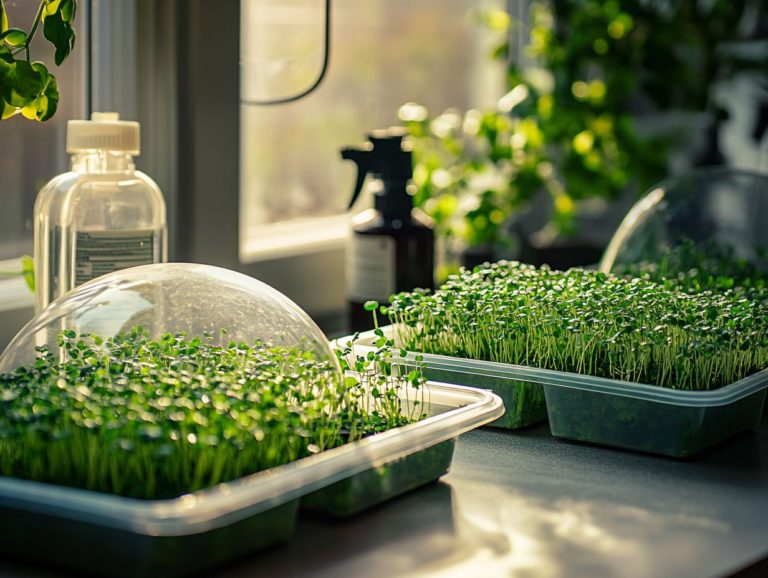Best Soil Mixes for Growing Microgreens
Microgreens are delightful, nutrient-dense greens that have captured the attention of culinary enthusiasts everywhere. They re simple to cultivate and provide a myriad of health benefits, all while helping you cut down on grocery expenses.
This article delves into the essentials of growing microgreens. It guides you through selecting the perfect soil mix, shares tips for successful growth, and highlights common pitfalls to steer clear of. Whether you re a seasoned gardener or just starting to explore this exciting venture, you ll discover valuable insights to embark on your microgreen journey with confidence!
Contents
- Key Takeaways:
- What are Microgreens?
- Benefits of Growing Microgreens
- Choosing the Right Soil Mix
- Top Soil Mixes for Microgreens
- Tips for Successful Microgreen Growth
- Common Mistakes to Avoid
- Frequently Asked Questions
- What are the best soil mixes for growing microgreens?
- Can I use regular garden soil for growing microgreens?
- What is the ideal pH level for soil used in growing microgreens?
- Do I need to add fertilizer to my soil mix for growing microgreens?
- What are the benefits of using a peat-based soil mix for growing microgreens?
- Can I make my own soil mix for growing microgreens?
Key Takeaways:
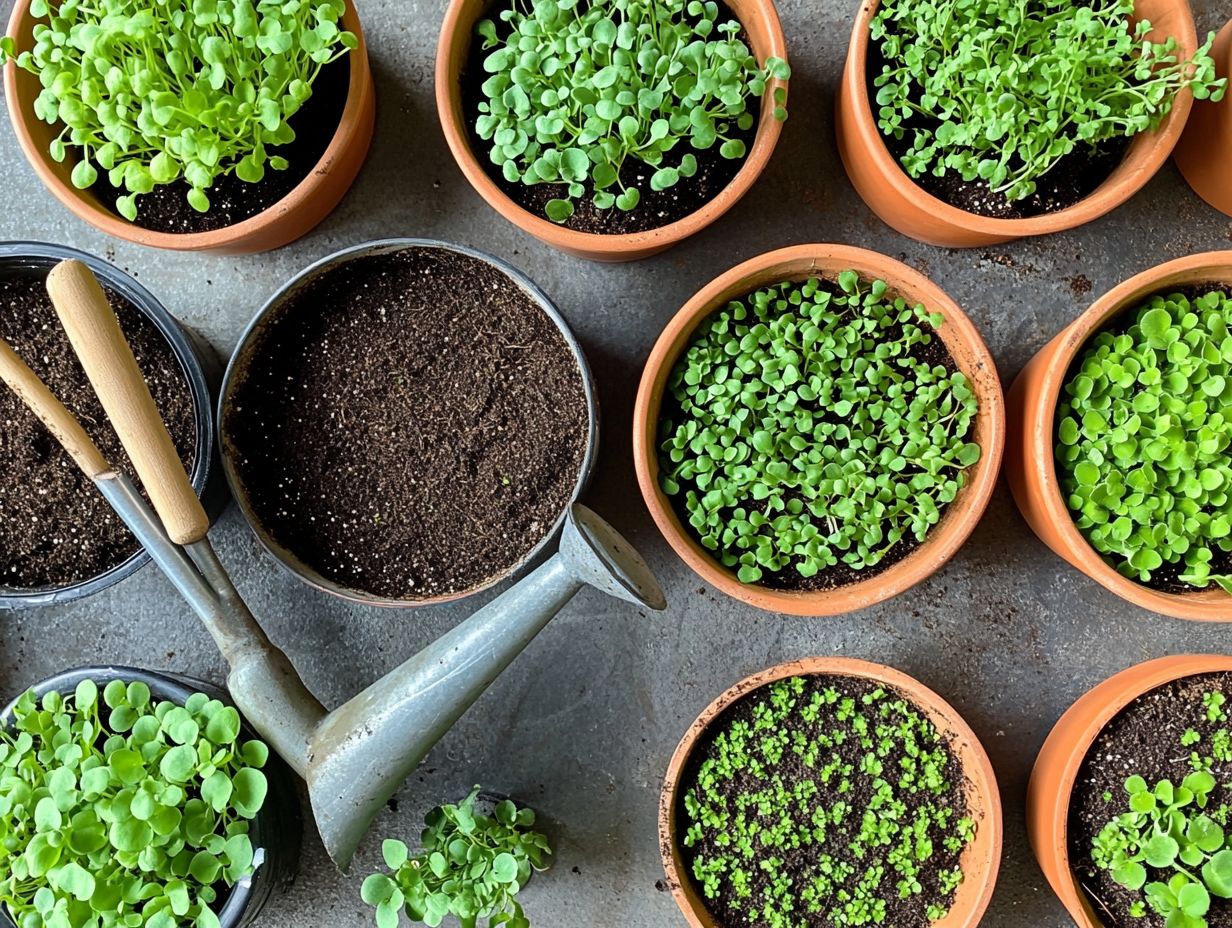
- Optimize nutrition and cost savings by growing microgreens.
- Select a soil mix with key components such as peat moss and vermiculite.
- Consider DIY mixes for control or store-bought mixes for convenience.
What are Microgreens?
Microgreens are young, edible plants harvested just after the first true leaves develop, usually within 7 to 14 days of germination. These nutrient-packed greens think Cabbage Microgreens, Broccoli, and Genovese Basil are often grown right in your kitchen. They re celebrated for their bold flavors and exceptional nutritional benefits.
With their intense flavors and vibrant colors, microgreens can transform a range of culinary creations. They elevate everything from salads and sandwiches to elegant garnishes for main courses. These tiny powerhouses aren t just versatile; they have an impressive nutritional profile, brimming with vitamins, minerals, and antioxidants that support health benefits like improved digestion and boosted immunity.
When growing microgreens, you have various methods at your disposal. Many enthusiasts choose between soil-based or hydroculture techniques (growing plants in water instead of soil). The growing medium you select greatly influences the quality and taste of your microgreens, as the right environment fosters optimal growth and maximum nutrient absorption. For those looking to enhance their microgreens, consider using natural fertilizers for microgreen growth.
Benefits of Growing Microgreens
Growing microgreens offers a plethora of benefits. Their remarkable nutritional value and cost savings elevate the flavor of your meals, making them a staple for health-conscious individuals and cooking enthusiasts alike.
These little powerhouses are easy to cultivate, even in compact spaces, making them accessible to anyone eager to enhance their kitchen experience.
Nutritional Value and Cost Savings
Microgreens deliver an impressive punch, boasting up to 40 times the nutrients of their mature counterparts. By growing your own microgreens, you gain access to fresh, nutrient-dense greens and enjoy substantial cost savings compared to pre-packaged options.
For example, when comparing nutrient-rich varieties like kale, radish, and sunflower microgreens, you ll find they contain significantly higher concentrations of vitamins C, E, and K than their fully grown versions. Studies suggest these tiny greens can deliver up to five times more vitamin C than mature kale.
With the rising costs of fresh vegetables, cultivating microgreens at home is a savvy financial choice. It often costs just a fraction of traditional grocery store prices. Their rapid growth cycle, taking less than two weeks, adds to the appeal. You can effortlessly harvest your own vitamins right from your kitchen windowsill.
Choosing the Right Soil Mix
Choosing the right soil mix for cultivating microgreens is essential, as it significantly impacts their growth rates, flavor, and nutritional value. Consider options like:
- Coconut Coir – Retains moisture effectively.
- Coco Loco Potting Mix – Blended for optimal drainage and aeration.
- Happy Frog Potting Soil – Enriched with beneficial microorganisms.
Each of these choices presents distinct advantages, creating the perfect environment for your microgreens to thrive.
Join the microgreen movement and start your gardening adventure today!
Key Components of a Good Soil Mix
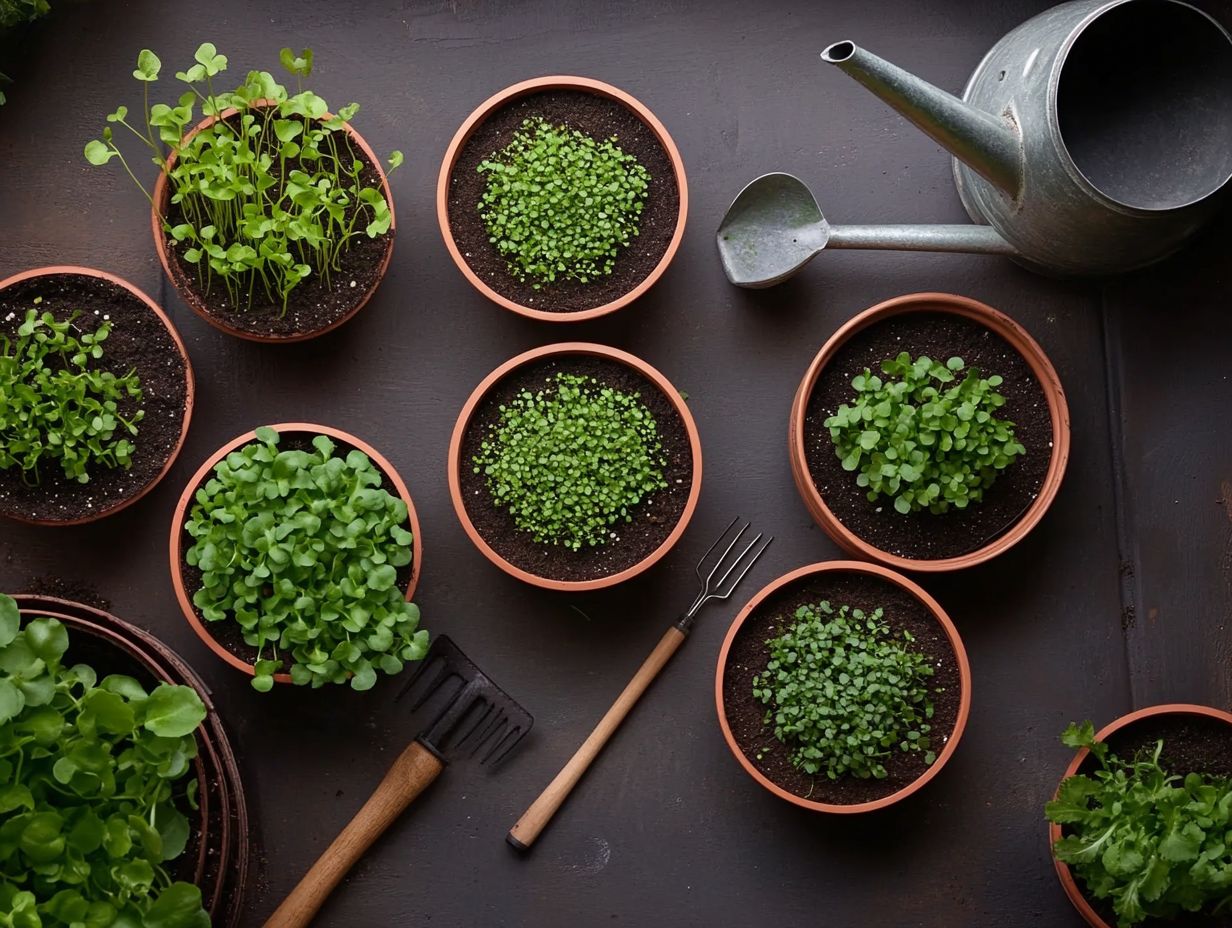
A high-quality soil mix for your microgreens should encompass essential elements such as organic matter, water retention capabilities, and vital nutrients. Look for ingredients like Earthworm Castings, Perlite, Composted Forest Humus, and Sphagnum Peat Moss. These components are the secret sauce for healthy growth and delightful flavor profiles.
Each ingredient plays a crucial role in your microgreens’ success. Earthworm Castings provide rich nutrients and improve soil structure for better root growth. Perlite enhances drainage and air circulation in the soil, preventing compaction that could hinder development. When starting your microgreens journey, consider choosing the right microgreen seeds as a key factor for optimal growth.
Composted Forest Humus enriches the mix with organic matter, fostering microbial activity that’s key for nutrient availability. Sphagnum Peat Moss retains moisture, ensuring your young plants receive consistent water essential for their growth.
When you balance these components, the resulting soil mix supports vigorous growth and elevates the overall vitality and flavor of your harvested microgreens.
DIY vs. Store-Bought Mixes
When selecting soil for your microgreens, you often weigh the merits of DIY mixes against store-bought options like Happy Frog Potting Soil and Coco Coir Bricks. Each choice has distinct advantages.
Crafting a DIY mix gives you exceptional control over ingredients. You can tailor your blend to optimize nutrition and drainage for the specific microgreens you wish to cultivate.
This approach can also be more budget-friendly, allowing you to experiment with components like peat moss, compost, or vermiculite. However, it may require more of your time and effort.
On the other hand, store-bought mixes offer convenience and are ready to use right out of the bag. While they can be pricier, they save you time, which is ideal for new gardeners or those short on time.
If you create a balanced DIY mix, start with a base of peat moss, add perlite for aeration, and incorporate worm castings for added nutrients. If you’re uncertain where to begin, opting for a reputable store-bought soil can lay a solid foundation for successful microgreens cultivation. You can also check out this guide on how to choose the right soil for microgreen growth.
Top Soil Mixes for Microgreens
Explore a fantastic variety of premium soil mixes for your microgreens! Popular choices include Coco Loco Potting Mix and Happy Frog Potting Soil.
Each option has its own set of advantages, tailored to meet diverse growing conditions and personal preferences. Choosing the right mix is crucial, as it significantly impacts the success of your microgreens.
Reviews and Recommendations
Reviews of popular soil mixes like Coco Loco Potting Mix and Happy Frog Potting Soil show significant variations in outcomes for microgreens. Selecting the right product is crucial for optimal growth.
User experiences reveal that some reported yields up to 40% higher with Coco Loco compared to other mixes. Happy Frog is praised for being rich in nutrients, promoting faster germination rates.
A recent study highlighted that your choice of soil affects not just plant health but also their flavor profiles, a detail that culinary enthusiasts value highly.
As microgreens rise in popularity, understanding the distinctions among various soil mixes gives the power to you to make informed decisions. This ensures consistent results that lead to lush, flavorful plants.
Tips for Successful Microgreen Growth
To achieve successful microgreen growth, it is essential to implement best practices regarding watering, light exposure, and soil selection. These factors play a crucial role in influencing growth rates and overall health.
By understanding the nuances of caring for these delicate plants, you can ensure a productive harvest that showcases your efforts.
Watering and Other Care Tips
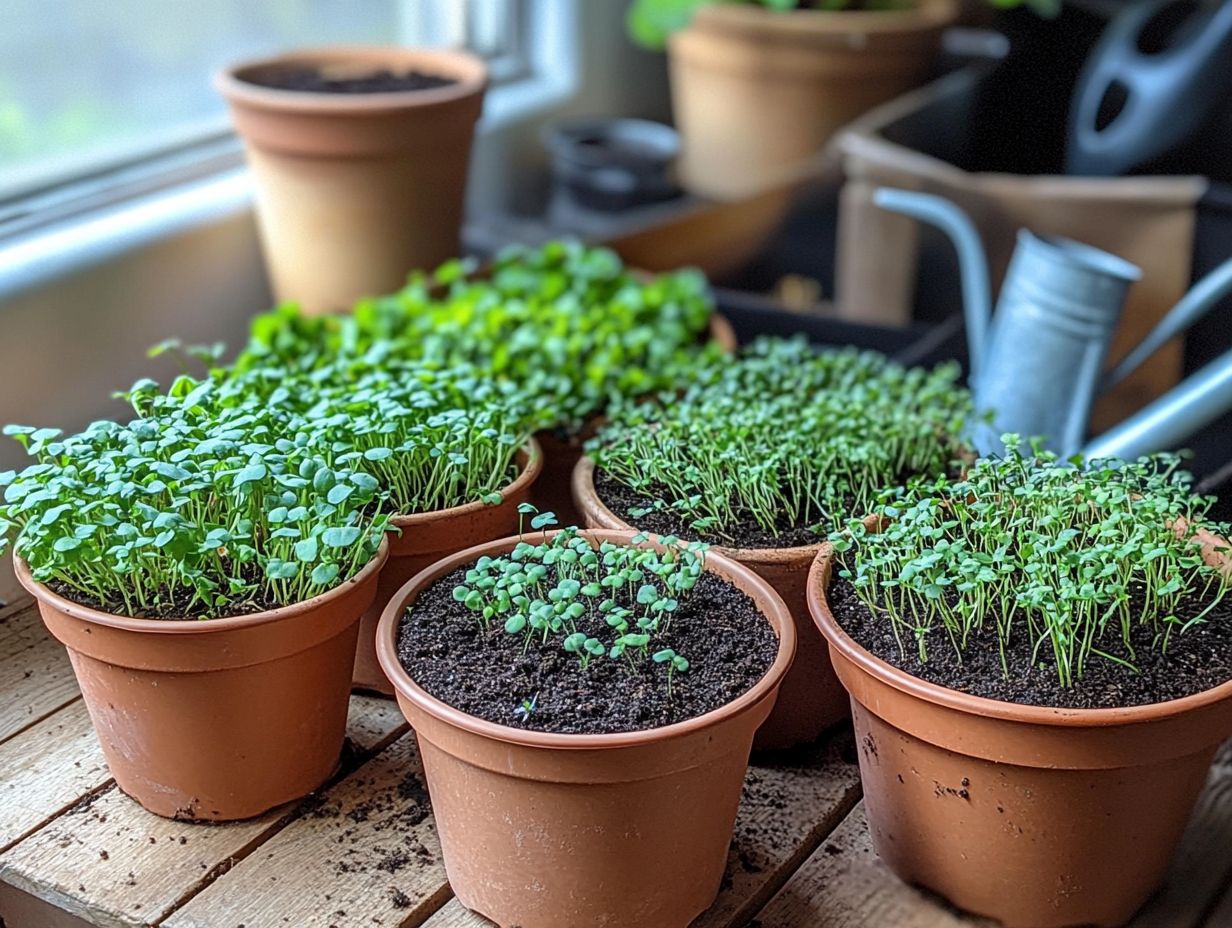
Effective watering practices and proper care tips are essential for optimizing your microgreen growth rates. This is especially important during the critical germination phase when the seeds are sprouting.
Keeping the soil consistently damp is crucial during this time. A fine mist spray bottle can help you achieve the right moisture balance without over-saturating the seeds. Water every one to two days, depending on the humidity, to foster robust growth. Consider using a gentle bottom watering method to encourage deep root development.
Keep a watchful eye on moisture levels to avoid any fungal issues. After the germination phase, ensure your microgreens receive the right amount of light to promote photosynthesis. For optimal growth, consider using soil alternatives for microgreen growing, regularly check for pests, and adjust airflow to enhance their overall health.
Common Mistakes to Avoid
When cultivating microgreens, it s vital to avoid common pitfalls to achieve optimal growth rates and a plentiful harvest. Many newcomers overlook key factors, such as seed germination techniques, which can lead to challenges that hinder plant development.
Problems and Solutions
Common issues affecting microgreen growth rates often stem from improper watering, insufficient light, or poor soil conditions. These can lead to stunted growth or lackluster flavor.
By identifying these challenges early, you can implement effective solutions that encourage strong root growth and examine root behavior.
You may also encounter problems like mold formation in overly damp environments or nutrient deficiencies that hinder vibrant leaf development. Utilizing Earthworm Castings can greatly improve your soil s nutrient profile.
Regularly monitoring moisture levels and ensuring proper air circulation can significantly reduce the risk of mold.
Adjusting your care routine such as incorporating a balanced fertilizer or enriching the soil with compost, including options like Coconut Coir or Mycorrhizae, can effectively address nutrient shortages. Additionally, using the best containers for microgreen cultivation ensures your microgreens receive the essential vitamins and minerals they need.
Keep a vigilant eye on pest infestations, like aphids or spider mites, for timely interventions. Introduce beneficial insects or apply organic sprays when needed.
This proactive approach promotes healthier plants and maximizes your growth potential, especially when using growth rates as a benchmark for success.
Frequently Asked Questions
What are the best soil mixes for growing microgreens?
The best soil mixes for growing microgreens are well-draining, nutrient-rich, and have a balanced pH. Popular options include peat-based mixes, coco coir mixes, and organic potting mixes.
Can I use regular garden soil for growing microgreens?
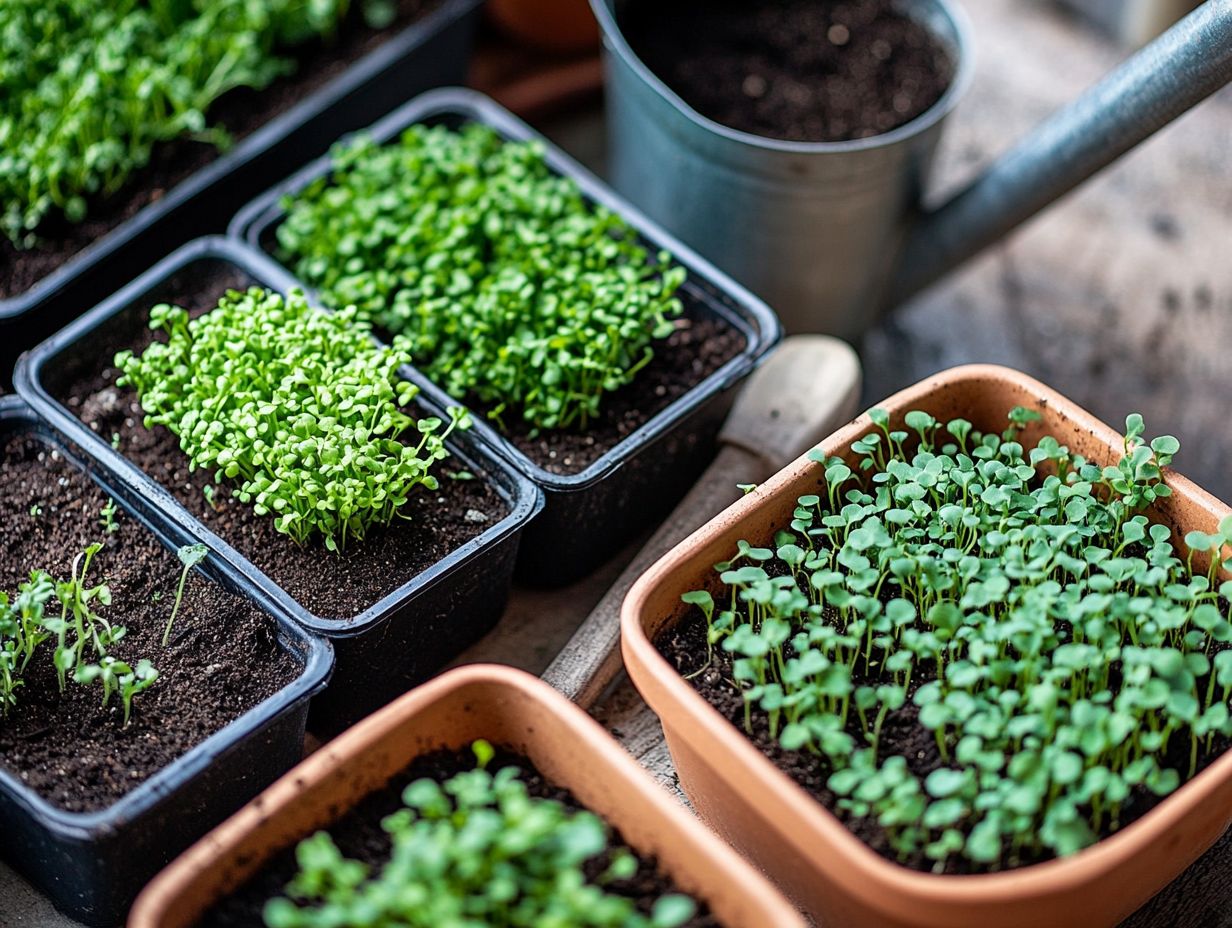
No, it is not recommended to use regular garden soil for growing microgreens. Garden soil can be too compacted and may contain pathogens or weed seeds that can hinder growth. It is best to use a specially formulated soil mix for microgreens, such as Soil for Microgreens or tailored soil media.
Ready to grow your own microgreens? Start today and enjoy the benefits of fresh, home-grown greens!
What is the ideal pH level for soil used in growing microgreens?
The ideal pH level for soil is between 6.0 and 7.0. This range helps microgreens grow better and absorb nutrients effectively.
Do I need to add fertilizer to my soil mix for growing microgreens?
Yes, adding a balanced organic fertilizer is helpful. A nutrient blend ensures that your microgreens have everything they need for healthy growth.
What are the benefits of using a peat-based soil mix for growing microgreens?
Peat-based mixes are lightweight and retain water well. They also provide essential nutrients and have a slightly acidic pH, which is great for microgreens.
Using peat is an environmentally friendly choice since it is a sustainable resource.
Can I make my own soil mix for growing microgreens?
Absolutely! Making your own mix can be fun and rewarding.
Just ensure that it drains well, is rich in nutrients, and has a balanced pH. A good mix might include sphagnum peat moss, vermiculite, and compost or coco coir bricks.

